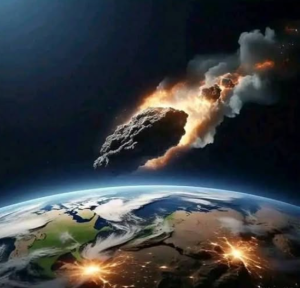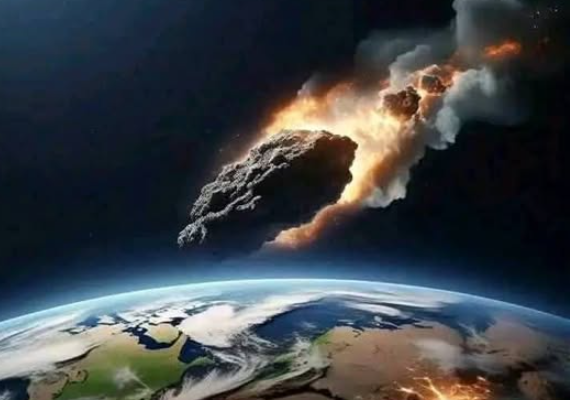
In recent months, the internet has been buzzing with alarming headlines claiming that a massive meteorite—often referred to as “Meteorite 2025 YR4”—is on a collision course with Earth. Posts, videos, and dramatic warnings have spread across social media, suggesting that a catastrophic impact could happen soon. But the truth behind these viral claims is much calmer, far more scientific, and rooted in the ongoing study of a real space rock known as Asteroid 2024 YR4. This asteroid has captured public attention because of its size and its close orbit to Earth, yet scientists are clear: there is no immediate danger of it falling to our planet.
Let’s break down what’s really happening.
Asteroid 2024 YR4 was first discovered on December 27, 2024, by astronomers using the ATLAS telescope in Chile. It was quickly classified as an Apollo-type near-Earth object, meaning that its path around the Sun crosses Earth’s orbit. Early data suggested the asteroid was somewhere between forty and ninety meters across—large enough to cause significant regional damage if it were to strike our planet. However, further measurements refined its size to roughly fifty-three to sixty-seven meters in diameter, or about two hundred feet across. That’s big enough to wipe out a city if it hit the ground, but far from being an extinction-level threat.
When newly discovered, objects like 2024 YR4 have large uncertainties in their orbital paths. Scientists use dozens of observations over days and weeks to calculate how they move through space. In those early days of discovery, computer models showed a tiny chance—slightly above one percent—that 2024 YR4 might strike Earth on December 22, 2032. That possibility, however slim, was enough to grab headlines. Some websites exaggerated the story, turning cautious scientific language into sensational claims. As happens often in the age of online virality, the nuance was lost, and fear took over the conversation.
As additional observations came in, astronomers refined the asteroid’s orbit with far greater precision. Using data from the James Webb Space Telescope and several ground-based observatories, NASA and the European Space Agency (ESA) recalculated its trajectory. What they found reassured everyone: the asteroid will not hit Earth in 2032. The chance of impact is now so small it’s considered virtually zero. In fact, scientists say it’s more likely that 2024 YR4 could strike the Moon rather than our planet. Even then, the probability of a lunar impact is only a few percent—still a low-risk event, though interesting from a scientific standpoint.
To understand why such rumors spiral, it’s helpful to know how asteroid tracking works. When astronomers discover a new object, they record its position against the background of stars multiple times. Each new observation helps narrow down its orbit. In the first few days, that orbit can appear uncertain enough that many possible paths intersect Earth. But as time passes and more data accumulate, those paths narrow, and most of the scary scenarios vanish. This is exactly what happened with 2024 YR4. What once seemed like a threat turned out to be a near miss.
So why do people call it “Meteorite 2025 YR4”? That’s partly a misunderstanding of terminology. A meteorite is a piece of rock that has actually entered Earth’s atmosphere and landed on the surface. What scientists are tracking is an asteroid, which remains in space. If an asteroid enters the atmosphere and survives the fiery descent to the ground, then it becomes a meteorite. As of now, 2024 YR4 is millions of kilometers away, safely orbiting the Sun. There is no evidence it will “fall to Earth” in 2025—or anytime soon.
Even though the danger is minimal, 2024 YR4 remains scientifically fascinating. Its orbit, for instance, is quite eccentric—it stretches about two and a half astronomical units from the Sun at its farthest point, bringing it past the orbit of Mars before swinging back inside Earth’s path. It also travels at a relatively low inclination, only about three degrees off the plane of the Solar System, making it easier to observe and model. Researchers are using radar and optical telescopes to determine its spin rate, composition, and surface features. Early analysis suggests it may be a stony asteroid composed largely of silicate materials, similar to many other near-Earth objects.
If, hypothetically, an asteroid the size of 2024 YR4 did hit Earth, the results would be devastating on a regional scale. For comparison, the 1908 Tunguska event in Siberia—believed to have been caused by an object between fifty and sixty meters across—flattened over two thousand square kilometers of forest. Such an impact releases energy comparable to several million tons of TNT. It wouldn’t destroy the planet, but it could obliterate a metropolitan area. That’s why scientists treat even small chances seriously: early detection gives humanity time to prepare or deflect.
Fortunately, the global planetary-defense community is better prepared than ever before. NASA’s Planetary Defense Coordination Office and ESA’s Space Safety program continuously track thousands of near-Earth asteroids. Missions like DART (the Double Asteroid Redirection Test) have already demonstrated that it’s possible to nudge an asteroid off course. DART successfully altered the orbit of the small asteroid Dimorphos in 2022, proving that planetary defense isn’t just science fiction anymore. Upcoming missions like Hera and NEOMIR will expand these capabilities, ensuring that any truly dangerous object can be detected and monitored years in advance.
As for 2024 YR4, scientists will continue to observe it whenever possible. The asteroid is currently moving into a position where it will be too faint for telescopes to track for several years, but it will become visible again around 2028. At that time, astronomers will refine its orbital path even more precisely, confirming what they already expect—that it will pass safely by Earth in 2032, possibly coming close enough for instruments to gather valuable data but far enough to pose no threat.
This event highlights a broader truth about our relationship with space: fear often comes from misunderstanding. The night sky is filled with asteroids, comets, and other celestial travelers, most of which have been orbiting peacefully for billions of years. Earth has indeed been struck in the past—sometimes with catastrophic results—but the odds of a major impact in any given decade remain extremely low. Still, vigilance matters. Continuous tracking allows us to separate genuine threats from false alarms, replacing fear with knowledge.
The story of 2024 YR4 is a perfect example of how science works in real time. A discovery sparks concern, data pour in, models evolve, and conclusions change as evidence grows. What began as a potential threat became a teaching moment for astronomers and the public alike. It showed how quickly misinformation can spread, but also how calmly and methodically scientists can provide clarity. Instead of panic, they offered perspective.
In the end, no, there is no meteorite named 2025 YR4 about to crash into Earth. The real object, 2024 YR4, will continue orbiting the Sun for years to come, watched carefully by observatories around the world. Its next significant approach will likely be a fascinating scientific opportunity—not a disaster. While dramatic headlines may continue to circulate, the facts remain steady: there is no danger, no impending impact, and certainly no reason to fear.
Still, these stories serve as reminders of our place in the cosmos. We live on a small blue world surrounded by countless pieces of rock and ice, all moving in silent patterns traced by gravity. Every new discovery, whether of a harmless asteroid or a potential near miss, adds to our understanding of that grand celestial dance. And thanks to science, we now have both the knowledge and the tools to ensure that the sky above us remains a source of wonder, not worry

